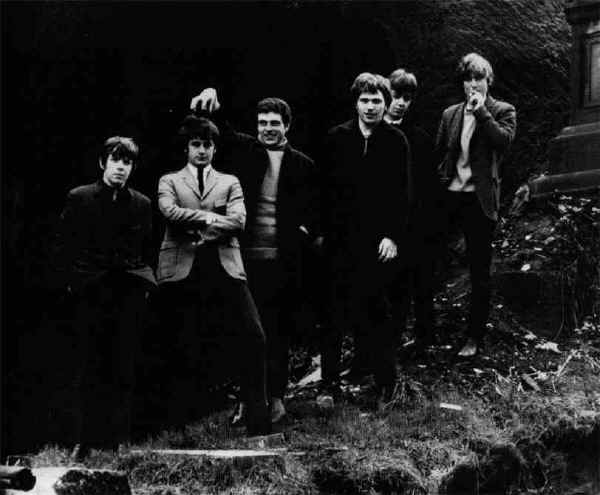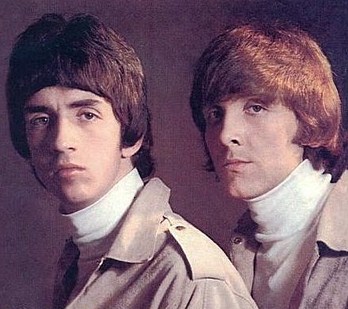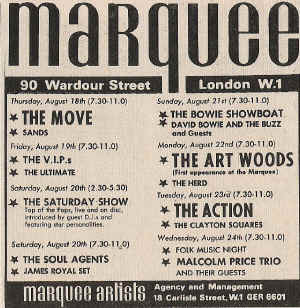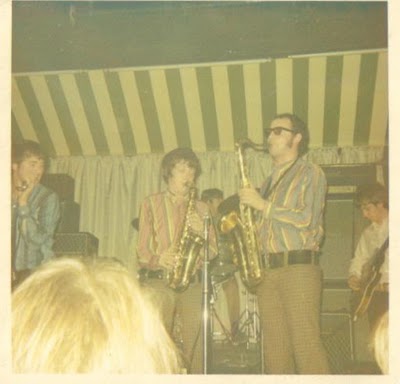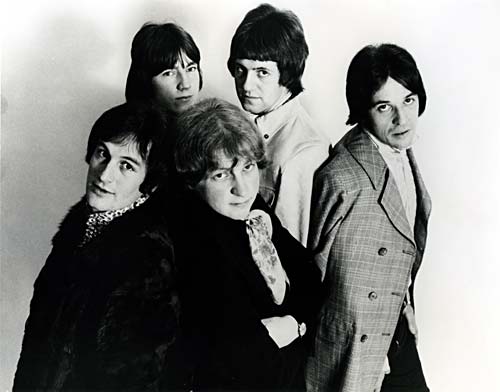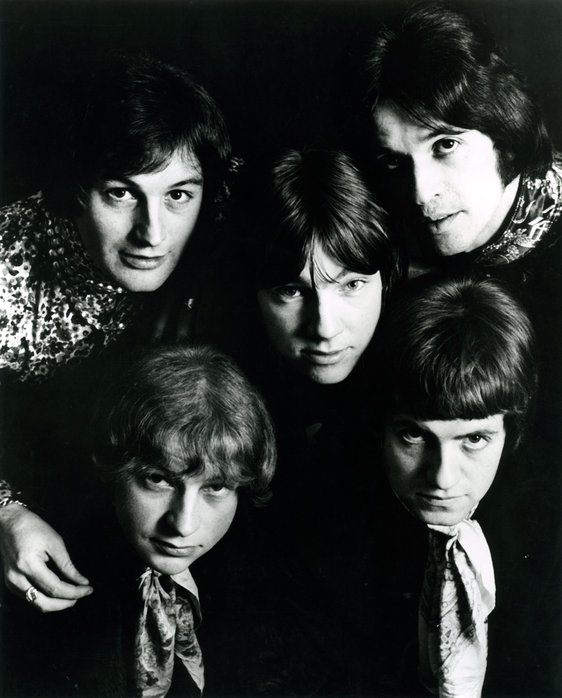By Nick Warburton
Singer Denny Alexander first came to prominence with Liverpool soul/mod specialists The Clayton Squares, who produced two great singles for Decca in 1965-1966. After a brief spell with The Thoughts, he joined the London-based Motivation, whose guitarist was none other than future Jethro Tull axe man Martin Barre. When the band changed name to The Penny Peeps in late 1967, Denny composed the band’s original material, most notably the mod-rock classic “Model Village”. He talks to Nick Warburton about his Sixties’ career.
The Clayton Squares (left to right), Mick Evans (Alto Sax), Denny Alexander (Singer), Pete Dunn Lead Guitar & Organ (now in Australia), Les Smith (Tenor Sax) (died in motor cycle accident shortly after leaving the band), Geoff Jones (Bass), Bobby Scott (Drums) (Died December 2010)Q) You are best known for your work with The Clayton Squares and The Penny Peeps. Tell me about how you first got involved in the music scene in your hometown, Liverpool?
I used to watch a group at a club in Liverpool and became friendly with them. They knew I played guitar and was looking to join a group. Anyway, one night I went to see them and they told me the other group on were looking for a rhythm guitarist and would I like an introduction? So I said I would watch their first set and see. I liked what I heard, got the introduction and an invite to audition, that went okay and they offered me the job. They were called Danny Havoc and The Ventures. However, Danny left after a couple of months and I took over lead singing with the group, changing its name to The Secrets (there was a band in the US called The Ventures).
This was all semi-pro as I was an apprentice joiner then which I enjoyed. The music scene was thriving and we had plenty of bookings but one night whilst playing I recognised two guys watching us. One was a previous drummer of The Secrets who had left to back another group; the other was Billy Kinsley who had just left The Merseybeats. It turned out Billy was to start up his own group and wanted me to be part of it. It all looked good; he had a record deal in place, a manager I knew, so I took the job on. But this meant I had to give up my job! This was to be professional musician, so I packed it in. Things started off very well. The band was called the Kinsleys for about six months. Then, the bombshell! Billy was re-joining The Merseybeats. We kept going and did the gigs lined up but were all a bit let down and demoralised. I decided I needed to do something else.
Q) How did you come to join The Clayton Squares?
The something else I decided was to look for another group, so I went to a pub on Mathew Street. I knew the Cavern D.J, a very knowledgeable Liverpool scene guy called Bob Wooler. We had a drink to see if he knew of any group looking for a singer/guitarist. Bob knew me from both The Secrets and The Kinsleys as both groups had played The Cavern on several occasions. Bob did know of a group who had just lost its singer and took me down to The Cavern where The Clayton Squares were practising and deciding what to do. After the introductions (they also knew who I had played with) they offered me an audition there and then, which I took up and that turned out well and the job was mine. I was now a Clayton Square! That was when I found out that Bob Wooler was their manager!
Q) The group missed the Merseybeat mania led by The Beatles but in my opinion was a much more exciting proposition than say Gerry & The Pacemakers. What stopped the group from being better known?
Basically we didn’t have hit records unlike Gerry & The Pacemakers or The Searchers.
Q) You were managed by Don Arden, what was he like to work with?
As I said earlier, Bob Wooler was the manager when I joined. Don Arden got involved later on after coming to The Cavern for a big show that was being transmitted to France. I think he was involved with one or two acts on the bill. The Squares’ role that night was to be in between other acts and as a warm up act during any delays in the recording. Don took an interest in us and following meetings with Bob and Don the decision to handle us jointly was made. We were then off to London to record and work over a wider area. We spent six weeks at one stage at the Star Club in Hamburg! What an experience that was. Don sorted the recording contracts and got us with the first record “Come and Get It” on to Ready, Steady Go! Eventually, he took over sole management.
Q) The debut single “Come and Get It” is a real cracker. Tell me about the recording of your debut single on Decca.
I’m glad you liked it, although we were offered another song first which we turned down! We, in our wisdom, thought it was a bit three chordy. What was it? Oh “Hang on Sloopy” before the McCoys’ version came out here. A great decision, eh? I don’t remember a lot about the recording; must be a senior moment. I remember though it was produced by a guy called Ian Samwell aka Sammy Samwell. I believe he wrote “Move It” for Cliff Richard.
Q) My personal favourite is “Imagination” which is a really gritty performance and features an emotional and powerful lead vocal from yourself. Tell me about your second single and why you think it wasn’t the breakthrough the band deserved.
I think “Imagination” could well have done better but the song offered was a Lovin’ Spoonful number called “There She Is”, which was deemed to give it a better chance. The original was a very country version which we changed all around. We were trying to be more original and maybe it wasn’t the hit music of the day.
Q) Is it true that you opened for Cream at the Marquee and Eric Clapton asked to borrow your guitar for their performance?
Yes, we did play with Cream. In fact, I think it was one of their first gigs. I believe Eric had just had his favourite guitar stolen. Anyway, after our first set he asked if he could use it on their next set; our guitarist had been using it and agreed, so Eric understrung it to his own style and used it. The problem was our guitar player wasn’t used to the understringing and struggled a bit second set using it that way. I was shortly going to sell the guitar and Eric Clapton did express an interest in buying it but it didn’t happen. The guitar was a double cut away Les Paul 59 special. I believe they were a limited edition and are worth a lot now. The guitar is long gone now, sold to Sound City in London although I often thought who might have it now.
Q) Did you do any more recordings before Clayton Squares folded around October 1966?
Yes, we did a version of Otis Redding’s “I’ve Been Loving You Too Long”, produced by Andrew Loog Oldham but it appeared that so many people wanted a slice of it so it never got released.
The Clayton Squares live at the Marquee, 1966, (left to right) Denny, Mike Evans (Alto Sax), Albie Donnely (Tenor Sax), Lance Railton (Guitar) (died approx 20 years ago), Back Bobby Scott (Drums), (not in shot Geoff Jones, Bass). Photo from http://londonwalkblog.blogspot.comQ) After the band split, you joined The Thoughts who worked quite a bit in Germany and appear on Beat Club I believe. How did this connection come about?
A lot of people were under the impression The Thoughts came from London especially after being introduced on Beat, Beat, Beat not Beat Club as “From London –The Thoughts” but they were a Liverpool band and I had known the bass player Alan Hornby for some time. In fact, Alan was with me at The Marquee when Cream played.
As the Squares were breaking up, The Thoughts had moved into the same hotel; they had backed a girl singer in Liverpool called Tiffany but had branched out on their own but after a while decided they wanted a lead singer. I just happened to be on hand and they knew me. They had just recorded a Ray Davies’ song called “All night Stand” but it didn’t take off for them. We did quite a bit of work in Germany but played a lot in the UK as well coming to an end in Carlisle when the van packed in. It was too expensive to repair and we couldn’t buy another so endeth The Thoughts. Great shame as I enjoyed my time with them.
Q) Around May 1967, you joined The Motivation which featured future Jethro Tull guitarist Martin Barre. How did the offer to front this band come about?
During my time with The Clayton Squares we played The Storyville Club in Frankfurt. Also playing there were Beau Brummel and The Noblemen. Bryan Stevens and Mick Ketley later of the Motivation were part of the Noblemen. When The Motivation needed to replace Jimmy Marsh, Bryan for some reason remembered me. I thought I had finished playing and with the Thoughts’ bass player Alan Hornby was making plans to open a small D.I.Y shop, but when Bryan offered me the chance to join – no audition by the way – I jumped at maybe one last chance. I then apologetically explained to Alan who fully understood. So off to Bognor Regis I went and Alan continued and opened the shop.
Q) During this period, you started to become quite a prolific writer. Tell me about your song-writing and what were your influences?
I had of course started writing when I was with the Squares but maybe being with The Motivation was giving me the motivation to write more. I can’t really put anybody in as a real influence. You’ve heard my stuff and can see it’s quite varied. But I was now finding it easier to write.
Q) In September 1967, The Motivation became The Penny Peep Show and then changed name to The Penny Peeps. You signed to Liberty Records and recorded two singles. The first features your excellent Mod classic, “Model Village” on the flip to the poppy “Little Man With a Stick”. I understand the band wanted your song on the A-side?
Yes, that’s true but like a lot of bands/artists around that time the recording company made the decision. “Little Man With A Stick” had been written by Les Reed and Barry Mason who had some major hits at the time. No doubt the record company felt their names would carry some clout.
Q) You composed the two sides of The Penny Peeps second and final single – “Curly, The Knight of The Road” c/w “I See The Morning”, which are quite a departure in sound to “Model Village”. Why do you think these songs were released when your other songs “Helen Doesn’t Care” and “Meet Me At The Fair”, which are more in tune with the band’s spirit were shelved?
At this particular time pop musicals had become very popular, and, yes whilst these two songs were a departure, I had it in the back of my mind to write a musical based on Curly who was very rich but very unhappy and with not a real friend who cared, so he gave up all his money and virtually became a tramp travelling around meeting nice people (just thought – a bit like Secret Millionaire now!).
I had talked to the record company about the idea which the liked and decided to go with the big production on those two tracks. Looking back maybe it should have been “Helen Doesn’t Care” although I have never known anyone called Helen the name just fitted the song!
Q) In August 1968, the band moved into a blues direction and changed name to Gethsemane. You only stayed around for a handful of gigs before suddenly leaving. Why did you decide to drop out?
I liked the move into the blues direction; it was actually my idea after we had been booked into a blues venue and hadn’t gone down too well in the first set. But basically I felt I’d reached the end of the road. Going on 25 it then seemed old, Time to get a proper job and all that stuff but I enjoyed my time playing with all those I worked with from the age of 18. I still see my good friend Alan from The Thoughts and have met up with both Bryan and Mick from the Penny Peeps and hope to do so again.
The Penny Peeps 1968, clockwise from top right: Denny, Malcolm Tomlinson, Bryan Stevens, Mick Ketley and Martin BarreQ) Tell me what you’ve been up to since you left the music business in 1968.
I went back to being a joiner for a short time before going into financial services where I had a bit more success with a few promotions along the way. I did carry on writing though and had some stuff put out on an album by a local cabaret band around 1972/3 but this was just for sale at their bookings.
Well retired now and spending lots of time looking after grandchildren. I am still playing though. I have three guitars, a six string acoustic, a 12 Stringer and a Fender Strat, but only play at parties with our group of friends at each other’s houses.
Thanks Denny for giving up your time to answer my questions.
Nick Warburton is a UK-based freelance writer, who has written for Shindig, Record Collector, the Garage Hangover website, Vernon Joynson’s book series and Richard Morton Jack’s new book, Endless Trip.
Copyright © Denny Alexander and Nick Warburton, 2011, All Rights Reserved. No part of this article may be reproduced without the permission of the authors.
